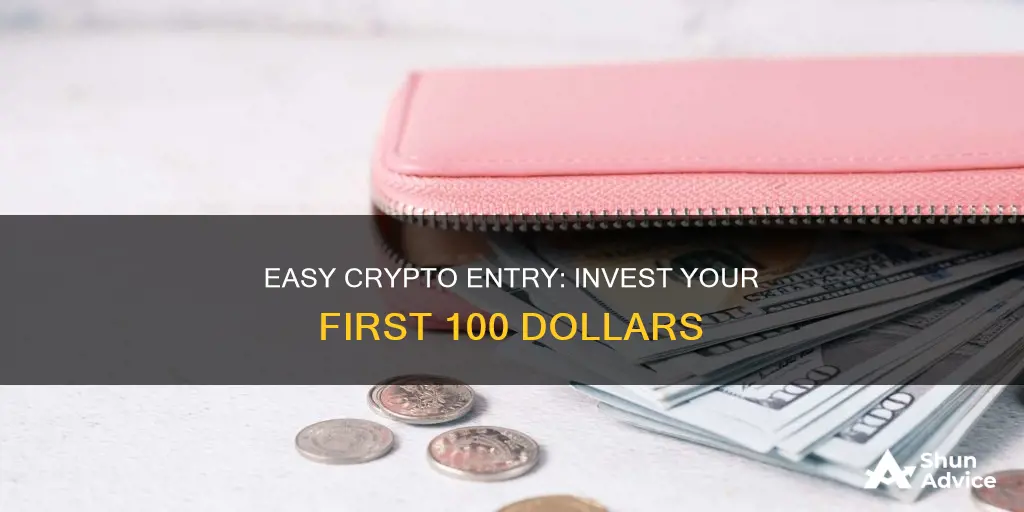
Investing in cryptocurrency has been called one of the greatest wealth transfers of our generation. With the crypto market cap increasing to $1.59 Trillion since the pandemic, many people are keen to invest in crypto. However, it can be difficult to know where to start, especially with the abundance of conflicting and complicated information out there.
If you have $100 to invest in crypto, you can make a profit, but you can also make a loss. Your $100 investment will only make a profit if the value of the cryptocurrency you invest in increases and you sell your asset.
There are several cryptocurrencies to choose from, including Bitcoin, Ethereum, and Cardano. Bitcoin is the largest cryptocurrency by market cap, and its value is driven by a variety of factors, including scarcity and the potential for high returns.
To invest in crypto, you will need a secure crypto wallet, a reputable cryptocurrency exchange, and a payment method.
| Characteristics | Values |
|---|---|
| Initial Investment | $100 |
| Cryptocurrency Choice | Bitcoin (BTC) or Ethereum (ETH) |
| Investment Options | Direct: Purchasing/Holding via Exchanges/ATMs, Trading |
| Indirect: ETFs, Blockchain-Related Companies | |
| Investment Period | Long-Term |
| Risks | Price Volatility, Lack of Regulatory Framework, Digital Threats, No Guaranteed Returns |
| Benefits | High Potential Returns, Liquidity, Future of Currency, Inflation Hedge |
| Investment Tools | Crypto Wallet, Crypto Exchange, Payment Method |
| Investment Strategy | Dollar-Cost Averaging, Diversification, Regular Investments |
| Investor Profile | Comfortable with Digital Assets, Understanding of Market Trends |
| Investor Considerations | Risk Tolerance, Financial Goals, Market Analysis, Investment Portfolio |
What You'll Learn

Where to buy crypto
There are several ways to buy cryptocurrencies, each with its own pros and cons. Here are some of the most popular methods:
Brokerage Services
Crypto brokers allow users to simply buy and sell cryptocurrencies. One of the most popular examples is the Crypto.com App, trusted by over 100 million users and available on both the Apple Store and Google Play.
Cryptocurrency Exchanges
These are online platforms where users can buy, sell, and trade cryptocurrencies using fiat currency or other cryptocurrencies. They offer more complex functions compared to a crypto brokerage, adding trading instruments like crypto derivatives. Examples of popular crypto exchanges include Crypto.com Exchange, Coinbase, Binance, and Kraken.
Peer-to-Peer (P2P) Marketplaces
These are platforms where buyers and sellers can directly trade cryptocurrencies without the involvement of a third-party exchange. This is also known as DeFi, short for decentralized finance. Multiple P2P crypto marketplaces can be accessed all in one app via the Crypto.com DeFi Wallet.
When choosing where to buy crypto, it is important to perform proper research and select a reputable platform. Additionally, it is advisable to store cryptocurrencies securely in a wallet, such as the Crypto.com App or Crypto.com DeFi Wallet.
Silver Eagle Coins: Smart Investment or Not?
You may want to see also

How to protect your investment
Selecting a Cryptocurrency for Investment
Start small, very small. Initially, invest in one, and learn about it as much as you can. Make mistakes with little amounts. Take baby steps. Choose carefully your sources of information and take all advice/news with a pinch of salt. Use established companies like Coinbase, BitPanda, and Bitcoin.de to buy your first Bitcoin or Indaccoin if you want to buy with a credit card.
Accumulation of Crypto Assets
Once an investor decides which crypto token to invest in, they should follow the age-old advice of slow but steady accumulation. Time provides plenty of opportunities for reflection, for competitors to come forth, and for the initial dust to settle. While you accumulate, you learn more about how the crypto project is developing and if it is delivering. On a cryptocurrency exchange like Spectrocoin, you can set buy orders for Bitcoin at certain levels. This allows you to “catch the dips” and buy at the prices you want to buy rather than at the market price. Given the cryptosphere is very volatile, going all in might lead to disappointment as the market could tank.
Protecting Your Crypto Assets
- Always use 2FA (two-factor authentication).
- Keep funds on exchanges for as little time as possible.
- Keep off-site backups.
- Use hardware wallets like Ledger Nano.
- Use a VPN (Virtual Private Network) like VPN Tunnelbear.
- Use a virus scanner like Emsisoft and VirusTotal.com.
- Use browser add-ons like HTTPS Everywhere.
- Use a password manager like Keepass (offline).
- Use backup tools and password-protect the wallets before you back them up with Veracrypt.
- Use advanced tools like Sanboxie and Oracle VM.
Curating Your Cryptocurrency Portfolio
Once invested in a particular cryptocurrency, you have the option to either store it safely and let it be or follow all developments in that space. Buying and holding is referred to as “HODL” or holding long-term. Both approaches have their pros and cons. The laid-back approach gives you time to focus on other priorities and avoid emotional roller coasters. The more intensive approach is an opportunity to learn and discover other opportunities.
Profit-Taking/Disbursement
Taking profit is never a bad idea in the cryptosphere. The market is extremely volatile and can easily throw a tantrum over any minor news item or rumour. This space is also not immune to fake news. Having a clear objective for each trade will make your crypto adventure more structured and less irrational. Be aware of survivor bias, which is thinking you can take profits early before all the other investors are rushing to the exits.
Tether Coin Investment: A Beginner's Guide to Getting Started
You may want to see also

How to buy fractions of Bitcoin
Bitcoin can be divided into 100 million units, each called a 'satoshi'. Each satoshi is worth 0.00000001 Bitcoin, or 0.01 uBTC (micro-Bitcoin). This means that you can buy Bitcoin for as little as the price of a single satoshi. At Bitcoin's current value, this would cost $0.00008.
However, most exchanges will not deal with buy orders of less than $5, and transaction fees can be over $5, so it is recommended that you buy at least $5 worth of Bitcoin. You will also need to consider fees involved in buying Bitcoin, which can be around $3 depending on the wallet/broker/exchange you use.
If you are new to Bitcoin, one of the easiest and most trusted ways to buy fractions of Bitcoin is through Coinbase. The signup process is straightforward, and your identity can be verified within 10-15 minutes. You can buy Bitcoin by linking your bank account, or by using a debit card.
Another option is Binance, which is a credible competitor to Coinbase, especially in non-US countries. Binance lists tokens and cryptocurrencies much quicker than Coinbase, so it is a good option if you want to diversify your digital assets.
Square's Cash App also allows you to buy fractions of Bitcoin. This is ideal if you are thinking in terms of investing a fixed number of local fiat, as the app takes care of the rest.
Other Ways to Invest $100 in Crypto
- Micro-investing apps or robo-advisors: These use apps or websites to learn about your financial needs and develop an investing strategy to meet them.
- Index funds: When you invest in a stock index fund, you buy a piece of every company held in that index.
- Fractional share investing: Instead of placing an order for a number of shares, you tell your broker how many dollars you want to invest in a stock.
- Retirement accounts: If you have a 401(k) or IRA, funding it could be an excellent use of your investment dollars.
Tyler Winklevoss' Bitcoin Bet: Millions Invested
You may want to see also

How to set up a digital wallet
Setting up a digital wallet is a crucial step in investing in cryptocurrencies. Here is a step-by-step guide on how to set up a digital wallet for your crypto investments:
Choose the Right Crypto Wallet for You
There are several types of crypto wallets available, each offering different features and security measures. The three most common types of crypto wallets are:
- Hosted Wallets: These are the most popular and user-friendly wallets. When you buy crypto through an app or platform, your assets are automatically stored in a hosted wallet. A third party, such as the platform or app owner, maintains your crypto for you, similar to how a bank manages your money in a savings or checking account. The significant benefit of a hosted wallet is that you won't lose your crypto if you forget your password. However, a drawback is that hosted wallets may not provide access to all crypto features.
- Non-Custodial Wallets (Self-Custody Wallets): These wallets give you complete control over your crypto assets. Non-custodial wallets do not rely on a third party to keep your crypto safe. While the wallet provider offers the necessary software to store your crypto, the onus of remembering and safeguarding your password or private key lies entirely on you. If you lose or forget your password, there is no way to retrieve your crypto. Non-custodial wallets are ideal if you want to access more advanced crypto activities like yield farming, staking, lending, and borrowing.
- Hardware Wallets: A hardware wallet is a physical device, similar in size to a thumb drive, that stores your private keys offline. Hardware wallets are considered more secure than software wallets, especially if your computer is hacked. However, they tend to be more complex and costly. Some popular hardware wallet options include Ledger and Trezor, which can cost upwards of $100.
Select a Reputable Platform or App
Once you've decided on the type of crypto wallet you want, it's time to choose a platform or app that offers that specific wallet. For example, Coinbase offers both hosted and self-custody wallets. When selecting a platform, consider factors such as security, ease of use, and compliance with government and financial regulations.
Create Your Account
Sign up on the platform or app by providing your personal information and creating a secure password. It is highly recommended to enable two-factor authentication (2FA) to add an extra layer of security to your account.
Buy or Transfer Crypto
Most crypto platforms and exchanges allow you to purchase crypto using a bank account or credit card. If you already own crypto, you can transfer it to your new wallet for safekeeping.
Download a Wallet App (For Non-Custodial and Hardware Wallets)
If you opt for a non-custodial or hardware wallet, you will need to download a wallet app. For non-custodial wallets, you typically don't need to share any personal information during the account creation process. However, it is crucial to write down your private key or seed phrase and keep it in a secure location. Losing this information will result in the inability to access your crypto.
Transfer Crypto to Your Wallet
For non-custodial and hardware wallets, you usually cannot buy crypto directly with traditional currencies (like USD or EUR). Instead, you will need to transfer crypto into your wallet from another source, such as an exchange or another wallet.
Remember, when setting up your crypto wallet, it is essential to prioritize security and only choose platforms and apps that have a good track record to minimize the risk of hacks or security flaws. Additionally, always keep your passwords, private keys, and seed phrases secure and accessible only to you.
Silver Coin Investment: A Beginner's Guide to Getting Started
You may want to see also

How to sell your crypto
There are several ways to sell your crypto, each with its benefits and drawbacks. Here are some of the most common methods:
- Exchanges: Cryptocurrency exchanges are the simplest way to sell crypto. The trades are almost instantaneous, and you can get up-to-date information as you trade. However, exchanges charge fees and may limit you to certain payment methods.
- Peer-to-Peer (P2P) Trading: P2P platforms allow you to choose your price and find a buyer willing to pay it. You can decide how to pay, such as through a bank transfer or gift cards. P2P trading provides more freedom and avoids exchange fees and limitations.
- Cryptocurrency ATMs: If you want to convert your crypto directly into cash, you can use a bitcoin ATM. These machines allow you to withdraw cash by entering your bitcoin wallet address. However, finding an ATM near you may be challenging.
- In-Person Trades: For the utmost privacy, you can trade crypto in person. You give cash to someone and receive access to a wallet of coins or have the bitcoin sent to you online. This method is risky since there is no option for an escrow service.
Step-by-Step Guide to Selling Crypto
Selling Crypto Through an Exchange:
- Go to the exchange's home screen and click on the "buy/sell" option.
- Select the "sell" tab.
- Choose how much crypto you want to sell, which crypto you want to sell, and your preferred currency to receive.
- Preview the sale and then confirm it.
Selling Crypto Through P2P Trading:
- Go to the P2P trading page on the platform (for example, Binance).
- Choose the "sell" option and set your crypto and fiat currencies. You can also specify the amount and payment method.
- Find a buyer whose price, payment limit, and payment method suit your needs.
- Choose how much crypto you want to sell and how you want to receive payment.
- Send the offer to the buyer.
- Once the buyer pays and the money is in your account, release the crypto to them.
Withdrawing Your Money
After selling your crypto, you can withdraw your funds in several ways, each with its own withdrawal fees:
- Bank Account: Attach your bank details to your exchange account and find the "withdraw" option. Select your bank account, choose the amount, and confirm the withdrawal.
- PayPal and Other Payment Services: Go to the "withdraw" section and select the payment service (e.g., PayPal). Enter the amount and confirm the withdrawal.
- Bitcoin ATM: If you want immediate cash access, you can withdraw funds from a bitcoin ATM. These machines allow you to get cash by entering your bitcoin wallet address.
Shitcoins: Exploring the Best Crypto Investments
You may want to see also
Frequently asked questions
Bitcoin is the world's largest cryptocurrency, and its value is driven by a variety of factors, like scarcity and potential for high returns. It offers high potential returns, liquidity, the prospect of being at the forefront of digital currency evolution, and a hedge against inflation due to its capped supply.
Investing in Bitcoin is risky due to price volatility, a lack of regulatory framework, susceptibility to digital threats, and the absence of guaranteed returns.
To invest in Bitcoin, you need a secure crypto wallet, a reputable cryptocurrency exchange, and a payment method. You can buy Bitcoin fractions up to $100, which means you don’t have to buy a whole coin.
A good Bitcoin wallet balances security, accessibility, and user-friendliness. The Exodus wallet is highly rated for its sleek interface and support for a large number of cryptocurrencies, making it ideal for beginners. Ledger, a hardware wallet that stores your Bitcoin offline, is also a good option.
The best way to start investing in Bitcoin is by using a reliable cryptocurrency exchange, like Coinbase.







